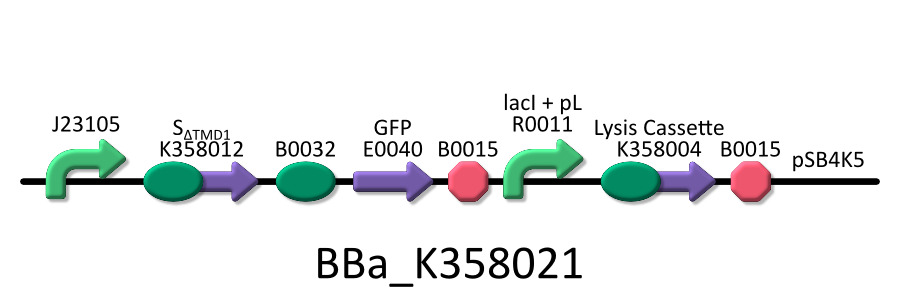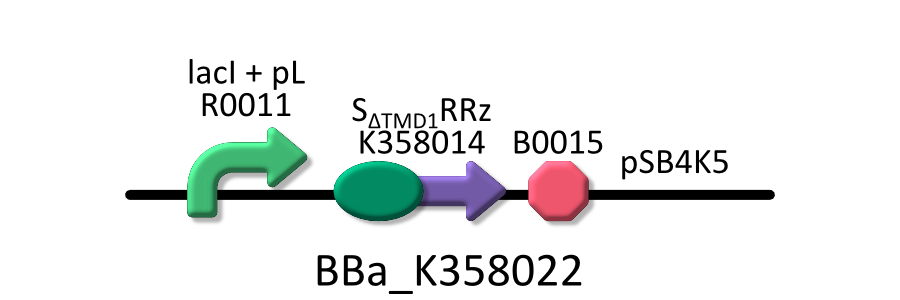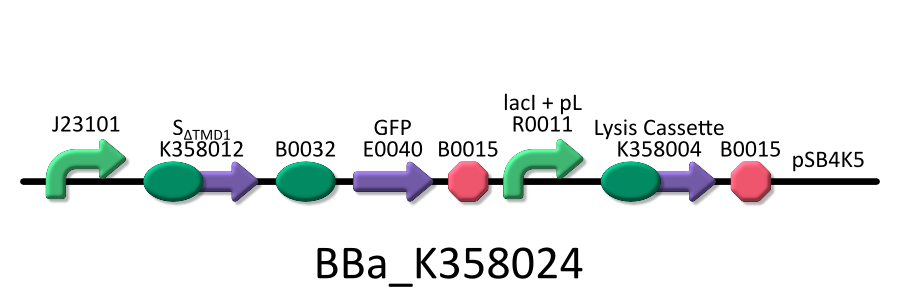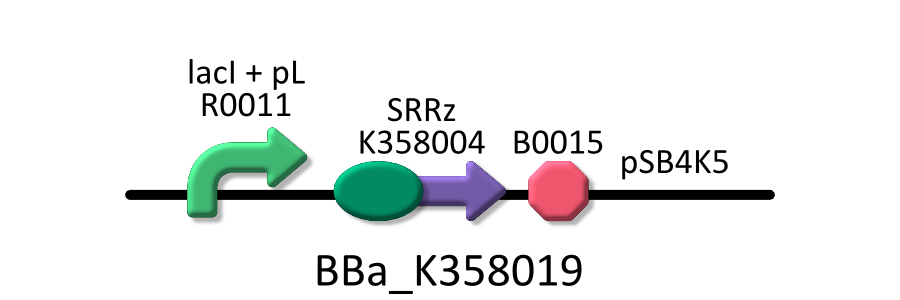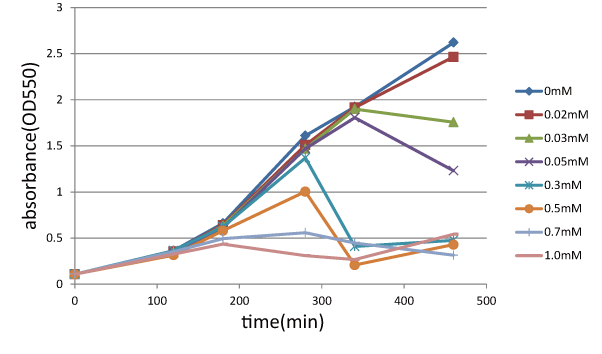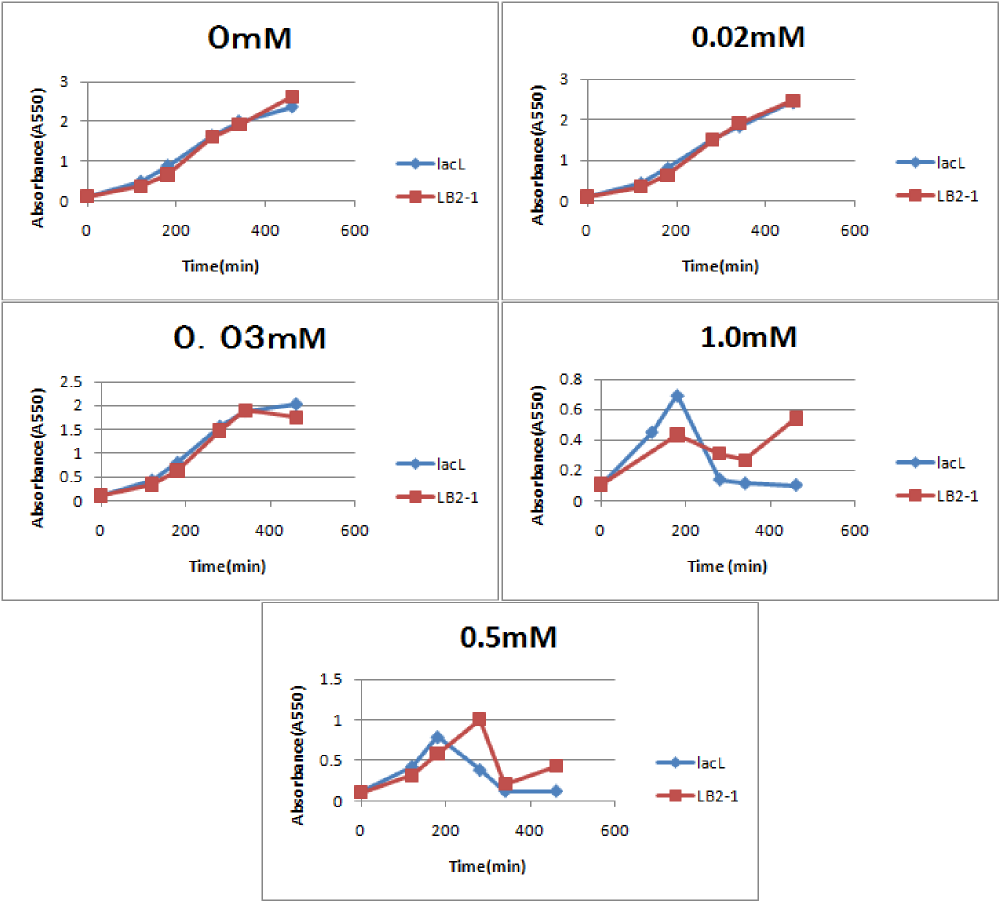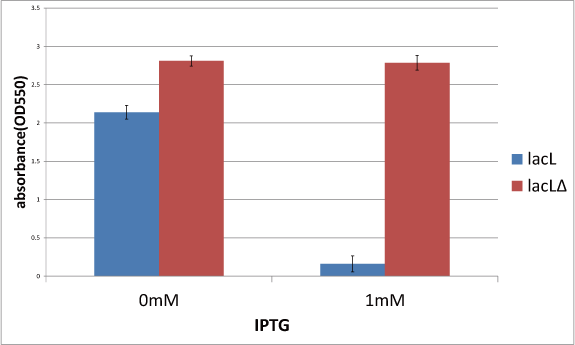Team:Kyoto/Project/Goal C
From 2010.igem.org
Goal C: Characterization of the anti-killer gene
Introduction
As long as we know, there are two anti-killer gene against the killer gene,lysis cassette, S107 and SΔTMD1. S107 is expressed by S gene encoded by lysis cassette and SΔTMD1 is an S allele with the transmembrane domein 1(TMD1) deleted. Because TMD1 of S gene is essential for the function of lysis cassette as killer gene, SΔTMD1 inhibits lysis cassette more strongly than S107.(Learn more) So, we selected SΔTMD1 as anti-killer gene.
Then, we checked if SΔTMD1 prevents lysis cassette from causing the cell death. To research this function of SΔTMD1, we used the E.coli transformed with both these genes( <partinfo>BBa_K358021</partinfo>). Because E.coli is immediately dead if killer-gene is constitutively expressed, we made lysis cassette regulated by lac promoter. The E.coli were grown in the medium without IPTG, and after there were enough E.coli, they were cultured in the one with IPTG to express lysis cassette. After that, we checked, by measuring the absorbance (A550), if E.coli were alive due to SΔTMD1 expressed constitutively.
Method
Bacterial strains
We used four types of E. coli, E. coli KRX transformed with <partinfo>BBa_K358021</partinfo>, KRX transformed with <partinfo>BBa_K358022</partinfo> KRX transformed with <partinfo>BBa_K358024</partinfo> and KPX transfomed with <partinfo>BBa_K358019</partinfo>. After this, We call each E.coli to abbreviate in order of name, LB2-1, lacLΔ, LB2-2 and lacL.
Construct
- <partinfo>BBa_K358021</partinfo>:Anti-killergene is induced constitutively and killergene is regulated by lactose promoter.
It was used in experiment 1
- <partinfo>BBa_K358022</partinfo>:lacP + SΔTMD1RRz, TMD1 is deleted from lysis cassette[SRRz].
It was used in experiment 2
- <partinfo>BBa_K358024</partinfo>:This part is the same to BBa_K358021, except for its constitutive promoter[BBa_J23101]. So, this part also induces constitutively SΔTMD1 gene, the anti-killer gene, and lambda lysis cassette[SRRz], the killer gene, is regulated by lacP.
It was used in the additional experiment, which is not finished.
- <partinfo>BBa_K358019</partinfo>:Lysis cassette regulated by lacP, Lysis cassette[SRRz] is regulated by lactose promoter. Activating lactose promoter and expressing SRRz gene, it causes the cell lysis. So, lactose promoter must be repressed when transform this part.
It was used in experiment 1 and 2
Mesurement
Experiment 1
We pick up three colonies from each plate, and cultivate them in the supplemented M9 medium overnight, about 16 hours. The overnight cultures were diluted to 0.1~0.11 in pre-warmed fresh the supplemented M9 medium. we measure A550 of the culture containing various IPTG at about 100 minute interval.
Experiment 2
We pick up three colonies from each plate, and cultivate them in the supplemented M9 medium for a night, overnight. The overnight cultures were diluted to 0.1~0.11mM in pre-warmed fresh the supplemented M9 medium. 18h later, we measure A550 of the culture containing 0mM or 1mM IPTG.
Result
Experiment 1: Function check of SΔTMD1
We measured the cell number of lacLΔ at several time after induction by adding several concentration IPTG. The result is below(Fig.1). This result showed that in the medium with more than 0.03mM IPTG, the number of E. coli is decreasing at a certain point. It demonstrated that In at least more than 0.03mM IPTG, SΔTMD1 can't inhibit lysis cassette completly. Then, we measured the cell number of lacL in the same way, and compared the result of lacLΔ with that of lacL to check how SΔTMD1 inhibited lysis cassette(Fig.2). In Fig.2, LacS is lacL, CTLS is the lacLΔ. From this result, we knew in more than 0.5mM IPTG both Lacs and CTLA were decreasing in the number at a certain point, or CTLA was a little delayed decreaing in the number. This demonstrated that SΔTMD1 can't correctly inhibit lysis cassette. So, we doubted whether SΔTMD1 really functioned as anti-killer gene. Although SΔTMD1 has no TMD1 of S gene, SΔTMD1 couldn't show the function as anti-killer gene.
Experiment 2:Check the role of TMD1 of S gene
Then, in order to check if TMD1 of S gene is essential for this killer gene, we measured the cell number of lacLΔ, which does not have TMD1 of S gene and that is, encodes SΔTMD1 and that of lysis cassette. This result is below(Fig.3). From this result, after IPTG was added,the number of lacLΔ is not decreasing, while the number of lacLΔ is decresing. It proved that SΔTMD1 cannot function as killer gene and TMD1 is essential for this killer gene, lysis cassette. In addition, in the medium without IPTG, the number of lacLΔ is larger than that of lacLΔ.This supports a report [1]. which says that more proteins which is short are expressed than the ones which is long.
Discussion
SΔTMD1 cannot inhibit lysis cassette completly
These results showed that SΔTMD1 cannot inhibit completely lysis cassette. This results can't supported a report on lysis [1]. which says that SΔTMD1 without TMD1 dominant-negatively inhibit lysis cassette. Why did we get the result against that report? Probably, there were three reasons below, we thought.
- SΔTMD1 in the plasmid did not worked correctly.
- S&DeltaTMD1 is weaker anti-killer gene than we expected.
- less SΔTMD1 proteins or more lysis cassette proteins was expressed than we expected.
Reason1:SΔTMD1 in the plasmid did not worked correctly.
To make sure the reason, we sequenced BBa_K358021 we used. It’s result showed that this construct is inserted into the plasmid correctly, which demonstrated that SΔTMD1 worked correctly. So, first reason was not right.
Reason2:S&DeltaTMD1 is weaker anti-killer gene than we expected.
As anti-killer gene against lysis cassette, there are two genes, S107 and SΔTMD1(Learn more). S107 is anti-killer gene, but because it has essential TMD1 of S for function of this killer gene, it’s function as anti-killer gene is weak compared with SΔTMD1, which does not have TMD1 of (Learn more). So, we thought that SΔTMD1 is a strong anti-killer gene, but from result of experiment 1 we doubted SΔTMD1 was a strong anti-killer gene. However, I could not make sure the reason.
Reason3:less SΔTMD1 proteins or more lysis cassette proteins was expressed than we expected.
in order to make sure this reason, we researched the expression level of killer gene, Lysis cassette and SΔTMD1. As a report [2] says, it is necessary for the inhibition of lysis cassette that there are at least 4.73 times more S107, anti-killer gene than lysis cassette proteins. So, Inhibition of this killer gene needs at least 4.73 times more anti-killer gene than killer gene. Then, we calculated the ratio of killer gene and anti-killer gene, assuming that S gene, which lysis cassette includes, produces 2.5:1 S107 and S105(Learn more), strength of S&DeltaTMD1 and S107 is the same. By this calcuration, we knew that in LB-1, the anti-killer gene couldn't inhibit killer gene in the medium with more than 0.1246mM IPTG. So, we insist that it is because SΔTMD1 was not expressed adequately that SΔTMD1 cannot inhibit lysis cassette completly.
Conclusion
We insist that the 3rd reason is right. Certainly, we have not made sure that 2nd Reason is not right. However, a report[1] says that SΔTMD1 inhibits lysis cassette. So, It is natural that we think SΔTMD1 have enough activity to inhibit lysis cassette.That is why the 3rd reason is right.
Then, in order to make sure the 3rd reason, we changed the promoter of SΔTMD1 to stronger one, and now, are checking the function of SΔTMD1. Surely, this result will help us discuss why SΔTMD1 couldn’t function as we expected. You must expect it!!
Reference
- Rebecca White, Tram Anh T. Tran, Chelsey A. Dankenbring, John Deaton, and Ry Young.2010.The N-Terminal Transmembrane Domain of _ S Is Required for Holin but Not Antiholin Function_. J. Bacteriol. 192: 725–733
- CHUNG-YU CHANG, KIEBANG NAM, AND RY YOUNG1. 1995.2 S Gene Expression and the Timing of Lysis by Bacteriophage λ. J. Bacteriol. 177: 3283–3294
 "
"


